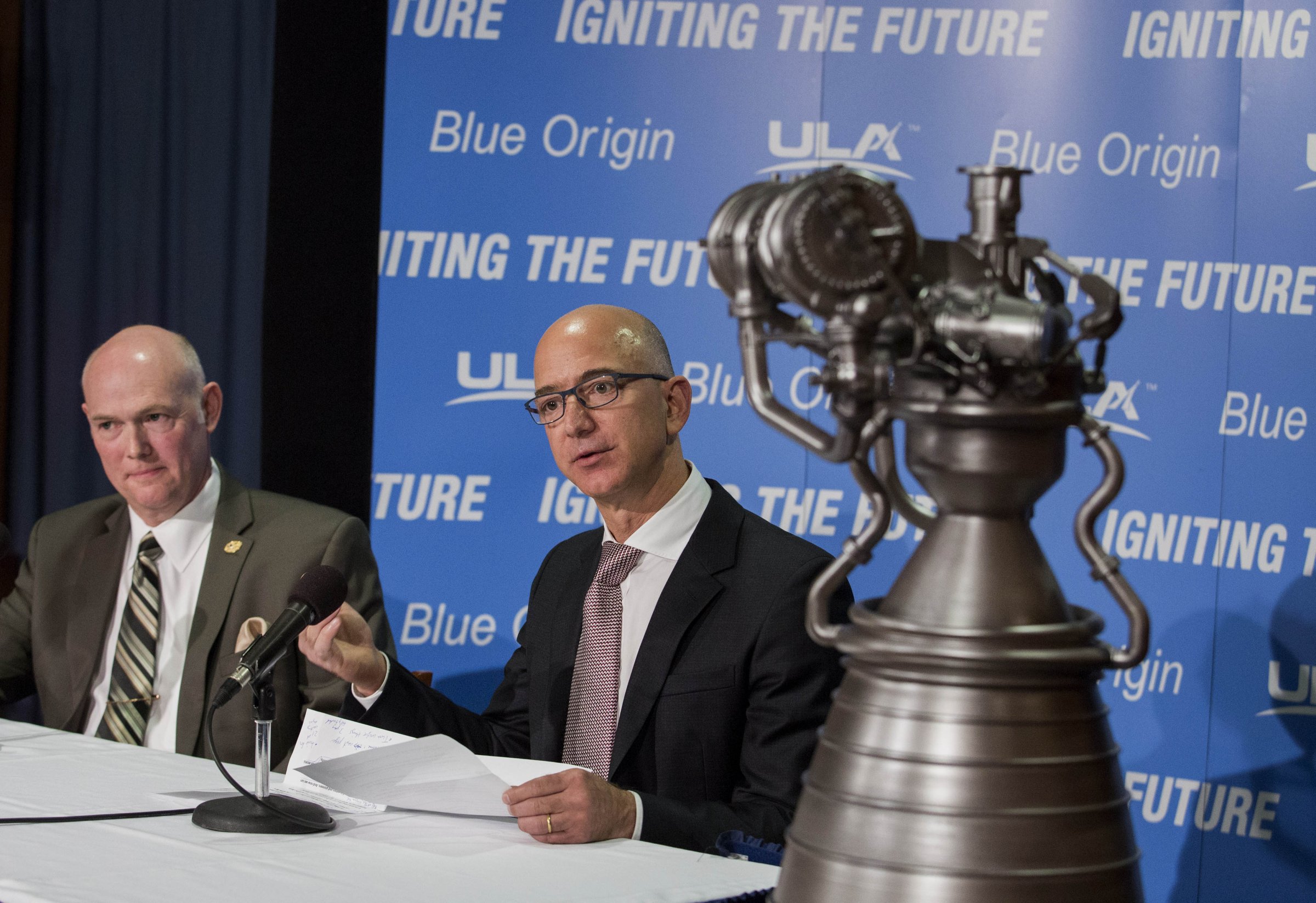
Time was, billionaires had no shortage of bling to buy—a yacht here, a Learjet there, a professional football team if you happen to have your Sundays free. But that’s all so yesterday. The must-have, 21st-century toy for the man with real cash to burn is fast becoming a spanking new spacecraft company.
That’s the way is seems at least, with Sir Richard Branson’s Virgin Galactic, Paul Allen’s Stratolaunch Systems, Elon Musk’s SpaceX and, most enigmatically of all, Amazon.com’s Jeff Bezos and his double super-secret, my-lips-are-sealed Blue Origin. While the other boys are anything but press shy, Bezos has kept his operation under a comparative cone of silence. The company is based in Kent, Washington, and while it doesn’t have any actual spaceships yet, it does have a website, some cool graphics and a very nifty coat of arms featuring what appear to be two turtles holding a shield with the Earth below them, the cosmos above and the motto Gradatim Ferociter (by degrees, ferociously) inscribed beneath. Really.
The last few days have been big ones for Bezos, however, with the announcement on Sept. 17 that he was partnering with United Launch Alliance (ULA)—itself a partnership of Lockheed Martin and Boeing—to produce a new engine for ULA’s workhorse Atlas V booster. Currently, ULA uses a Russian-made RD-180 engine in the first stage of the Atlas. That became both politically and logistically untenable last spring, after the Russian invasion of Ukraine, Western sanctions against Moscow and an announcement from Russia that it would tighten sales of the engine in retaliation.
So it’s good news that ULA is swapping out its hardware, but huge news—at least judging by the media response—that the universe’s biggest bookseller is part of the deal. The Washington Post—which is owned by . . . oh, let me check my notes. Ah yes, Jeff Bezos—declared the news “a historic partnership between ‘Old Space’ and ‘New Space.’” Bloomberg News and Businessweek, noting the bad blood that has long existed between Musk and Bezos in the race for the high ground, declared it a “battle of the billionaires” and even ran a madcap little graphic showing the two lads jousting on the backs of cartoon rockets, because why not?
But let’s sweep away the packing peanuts and see what’s really inside this latest shipping box. First of all, this may be a Musk-Bezos cage match, but if so, Bezos really should have been part of the undercard. It is a not inconsequential fact that he has yet to fire so much as a push pin into space, while Musk’s SpaceX is already flying satellite payloads for paying customers and is about to make its fourth unmanned cargo mission to the International Space Station (ISS). Bezos has been talking for a while about taking paying tourists to suborbital space—a dream Branson is chasing too—but he is vague about when this will happen and shows no signs at all of having the wherewithal to do it.
Then too there was the timing of his big announcement, which occurred on the very day that NASA announced the companies it had chosen—after a years-long competition—to take over the business of flying astronauts to the ISS. The two winners were Boeing and, yes, Musk. It’s true that nobody knew exactly the day or time that NASA would be revealing its picks, but everybody in the space world did know it was coming sometime in mid-September. Bezos may or may not have intended to spit in the other guys’ soup, but that’s what he wound up doing.
In fairness to Bezos, the engine he is developing, dubbed the BE4 (for Blue Engine), sounds like a real gem. Most rocket engines run on a combination of liquid oxygen and a fuel known as RP1—which sounds a little less nifty when you realize it stands simply for Rocket Propellant 1, and a lot less nifty when you realize that means kerosene. Bezos plans to replace that with far cleaner liquefied natural gas. He also makes the very good point that most of the engines flying today (excluding Musk’s) were designed in the 50s, 60s and 70s and it really is time to bring 21st century materials and computer models into the mix. One BE4 could produce 550,000 lbs. (250,000 kg) of thrust. That’s less than a Russian RD-180 and much more that Musk’s Merlin. But engines are routinely bundled—Musk’s biggest working booster has 9 Merlins and NASA’s historic Saturn V moon rocket had five massive F-1 engines—so thrust is by no means a deal-breaker.
But the thing is, the F-1’s were real, as is the Merlin and as is the RD-180. The BE4, like so much in the space billionaire’s toy box, is either vaporware or hardware that has yet to actually do anything. Bezos and ULA do promise their engine will be flying by 2018—unless, of course, it’s not.
That uncertainty is the biggest message that guys who fancy themselves Masters of the Universe (albeit on Earth) have to learn. Space travel is hard—exceedingly, often lethally hard. You can’t negotiate with physics or bully orbital mechanics. You can’t delete gravity’s Buy button. Elon Musk—so far—is making a real go of things. The rest are little more than dreamers until proven otherwise. It’s not business, fellas, it’s science.
More Must-Reads From TIME
- The 100 Most Influential People of 2024
- Coco Gauff Is Playing for Herself Now
- Scenes From Pro-Palestinian Encampments Across U.S. Universities
- 6 Compliments That Land Every Time
- If You're Dating Right Now , You're Brave: Column
- The AI That Could Heal a Divided Internet
- Fallout Is a Brilliant Model for the Future of Video Game Adaptations
- Want Weekly Recs on What to Watch, Read, and More? Sign Up for Worth Your Time
Write to Jeffrey Kluger at jeffrey.kluger@time.com